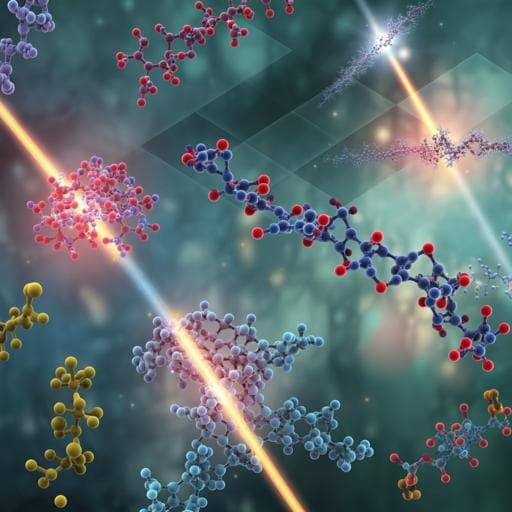
Chemistry
Photoswitchable dynamic conjugate addition-elimination reactions as a tool for light-mediated click and clip chemistry
H. Lu, H. Ye, et al.
Discover exciting advances in photoswitchable covalent reactions that allow for dynamic control of molecular connections and disconnections! Conducted by Hanwei Lu, Hebo Ye, Meilan Zhang, Zimu Liu, Hanxun Zou, and Lei You, this research showcases innovative applications in surface modification and polymer manipulation through light-mediated processes.
~3 min • Beginner • English
Introduction
Dynamic covalent chemistry (DCC) enables reversible formation and scission of covalent bonds, imparting adaptability, self-correction, and recyclability to molecules, assemblies, and materials. Within this context, click reactions offer modular bond construction, while clip (declick) reactions enable efficient bond cleavage. Introducing light as a stimulus provides spatiotemporal control and access to high-energy states, making photoswitches ideal actuators for DCC. Prior work realized light-gated DCC through masking/unmasking of reactive groups (e.g., Diels–Alder, imine chemistry) or by modulating equilibria via photoswitchable intramolecular interactions (e.g., azobenzene/boronic esters). However, photoswitchable DCC remains limited in scope. The authors target Michael-type conjugate addition and addition–elimination reactions—widely used DCRs with tunable thermodynamics/kinetics via acceptor design and leaving groups—to enable light-addressed exchange of thiol and amine nucleophiles for both bond formation (click) and scission (clip). The central hypothesis is that coupling a Michael acceptor to a dithienylethene (DTE) photoswitch will modulate the antiaromatic character of key enol intermediates and transition states upon ring opening/closing, thereby changing reaction barriers and enabling on/off light control over dynamic exchange across diverse nucleophiles.
Literature Review
The study builds on extensive literature in DCC and click/clip chemistry, including reversible Michael reactions and their application to materials (COFs, adaptable networks) and degradable polymers via 1,3-dicarbonyl-derived acceptors. Light-gated DCC has been demonstrated using diarylethene masking for Diels–Alder and imine chemistries, and with azobenzene/acylhydrazone-tuned boronic ester exchange via intramolecular H-bonding. Recent work from the authors leveraged photoinduced ring–chain tautomerism for switching stability/degradability in covalent systems. Despite these advances, photoswitchable dynamic conjugate addition–elimination reactions are rare; achieving broad, efficient, and reversible light control across thiol and amine exchanges addresses a notable gap.
Methodology
Design and synthesis: A 4-cyclopentene-1,3-diketone-based Michael acceptor (1) was fused to a dithienylethene (DTE) photoswitch on the ethene bridge. The diketone was converted to 2-(ethoxymethylene)-4-cyclopentene-1,3-diketone (o-1) by condensation with triethyl orthoformate. DTE substitution and assembly proceeded via a Wittig–Horner route involving 2,3-dithienylmaleic anhydride and phosphorus ylide. Photocyclization (313 nm) afforded the closed-ring c-1; 650 nm light reverted to o-1. Photoswitching was characterized by 1H NMR and UV–Vis, showing high reversibility and fatigue resistance.
Reaction studies: Dynamic conjugate addition–elimination reactions with thiols and amines were conducted in CD3CN (typically ~5 mM acceptor; thiols 3.0 equiv., primary/secondary amines 1.5 equiv.) and monitored by 1H NMR and UV–Vis spectroscopy. Kinetics were compared for o-1 vs c-1 toward alcohols, thiols, and amines; exchange reactions were also examined using in situ generated enol thioethers (2) and enamines (3). Representative conditions: c-1 with 1-propanethiol reached completion in 12 h; o-1 changed little over weeks; c-1 with aniline completed in 3 min vs 26 h for o-1; c-1 with diisopropylamine completed in 3 min vs 7 days (80%) for o-1. Exchange reactions included thiol/thiol, amine/thiol, and amine/amine scramblings, comparing reactivity of o-2/c-2 and o-3/c-3.
Kinetic/thermodynamic analyses: Temperature-dependent kinetics for reactions with 1-propanethiol (10 equiv.) provided Arrhenius parameters and activation energies. Additional rate constants for aniline reactions at room temperature showed broad rate modulation. Crystallography confirmed o-3 structure and intramolecular H-bond stabilization.
Computations: DFT calculations (Gaussian 09) at M06-2X-D3/def2-SVPP with PCM (acetonitrile) identified concerted six-membered transition states (TS) for nucleophilic addition/proton transfer (TS1) and ethanol elimination (TS2), intermediates (enol thioacetals o-4/c-4), and relative barriers. Single-point energies at M06-2X-D3/def2-TZVPP and NICS(1)zz values assessed (anti)aromaticity contributions to barrier modulation.
Applications: Surface functionalization on MTS-modified porous silica-coated glass slides compared reactivity of o-1 vs c-1 and reversibility via amine/thiol exchange and photoswitching (contact angle measurements). Spatial patterning on paper employed masked irradiation and thiol vapor treatment. Amphiphilic assemblies were created in situ by coupling a hydrophilic oligo(ethylene glycol) thiol (PEGSH, 5) to c-1, forming c-2 amphiphiles; morphology assessed by TEM/SEM and modulated via light and amine exchange. Polymer networks: A bifunctional DTE–Michael acceptor (6) and a tetra-thiol crosslinker (7) were polymerized under 313 nm to yield c-8; switching to o-8 with 650 nm; degradation triggered by amines (e.g., aniline) via amine/thiol exchange. Characterization included rheology (G′/G″), FTIR, GPC, NMR, MS, TGA, and DSC. Illumination used a xenon lamp with bandpass filters at 313 ± 10 nm (2.6 W) and 650 ± 10 nm (16.6 W).
Key Findings
- Photoswitching of DTE-modified Michael acceptor toggles reactivity: the closed-ring c-1 is significantly more reactive than open-ring o-1 toward conjugate addition–elimination with thiols and amines.
- Representative kinetics and conversions (Table 1 and figures):
• With 1-propanethiol (3 equiv.): o-1 produced 38% o-2 after 35 days; c-1 reached 100% c-2 in 12 h. Aromatic thiols and sterically hindered thiols followed the same trend (e.g., p-toluenethiol: c-2 95% in 27 h; o-1 unreactive over 7 days). Cysteine addition to c-1 completed in 3 min (quantitative) in aqueous media.
• With 1-butylamine (1.5 equiv.): c-1 reacted within 30 s (25 µM, UV–Vis), while o-1 required ~13 min. With aniline: c-1 completed in 3 min; o-1 required 26 h (>10× rate enhancement). With diisopropylamine: c-1 completed in 3 min; o-1 reached 80% in 7 days.
• Exchange reactions mirrored this switchability: thiol/thiol exchange fast with c-2 (e.g., benzylthiol displaced 1-propanethiol in 2 h) but slow with o-2; amine/thiol exchange (e.g., aniline cleaving C–S) rapid for c-2 but suppressed for o-2; amine/amine exchange rapid with c-3 (minutes to days depending on partners) but very slow with o-3 (often tens of days with low conversion).
- Experimental activation energies (Arrhenius): 17.46 kcal·mol⁻1 for o-1 → o-2 vs 12.15 kcal·mol⁻1 for c-1 → c-2 with 1-propanethiol, consistent with faster c-1 reactivity.
- DFT mechanistic insights: Both addition/proton transfer and ethanol elimination proceed via six-membered TSs. The metastable closed-ring raises ground-state energy yet stabilizes TSs and enol intermediates through reduced antiaromaticity, lowering barriers by ~5.7 kcal·mol⁻1 (computed), matching experiment (~5.3 kcal·mol⁻1 difference).
- Aromaticity metrics: NICS(1)zz for enol intermediates: o-4 = +17.53 ppm (antiaromatic) vs c-4 = −0.25 ppm; for TSs: o-TS1 = +11.16 ppm, o-TS2 = +11.39 ppm vs c-TS1 = −0.59 ppm, c-TS2 = +0.75 ppm, evidencing antiaromaticity breaking upon photocyclization.
- Applications:
• Surface functionalization: c-1 grafted onto thiol-functionalized silica-coated glass (contact angle 68.2° → 93.2°); o-1 showed no modification. Amine treatment (aniline) cleaved the C–S bond for c-2 (93.2° → 70.5°); light-locking in o-2 prevented exchange (88.5° → 87.7° after aniline).
• Spatial patterning: selective irradiation and thiol vapor enabled patterned, multicolor, and switchable modifications on paper.
• Amphiphiles: c-2 (PEGSH) formed ~200 nm spherical assemblies (TEM/SEM) that disassembled upon aniline via C–S cleavage; assemblies retained when switched to o-2 (exchange off).
• Polymers: 313 nm light induced network formation (c-8) from bifunctional acceptor 6 and tetra-thiol 7; 650 nm yielded o-8. Aniline triggered c-8 degradation (G′ < G″), while o-8 remained solid-like (G′ > G″). Degradation also achieved with piperidine and diisopropylamine.
Discussion
The study demonstrates that integrating a DTE photoswitch into a 1,3-diketone-derived Michael acceptor enables light-controlled modulation of dynamic conjugate addition–elimination reactions. Photocyclization to the closed-ring form decreases antiaromaticity in key enol intermediates and transition states, reducing kinetic barriers and accelerating both formation and exchange processes with thiol and amine nucleophiles. This validates the hypothesis that aromaticity modulation can gate DCR kinetics and provides a generalizable strategy for photogating reversible click/clip reactions. The significant rate enhancements (from minutes to days differences) and broad nucleophile scope translate into practical control over covalent connection/disconnection in varied environments, enabling reversible surface functionalization, spatially resolved patterning, responsive amphiphilic assemblies, and on-demand construction/degradation of polymer networks. These results address the challenge of limited scope in photoswitchable DCC and highlight the utility of aromaticity-driven kinetic control for precise spatiotemporal manipulation of dynamic covalent bonds.
Conclusion
A photoswitchable platform was established for dynamic conjugate addition–elimination by coupling a DTE switch to a Michael acceptor, enabling light-gated exchange of thiol and amine nucleophiles for reversible click and clip chemistry. Mechanistic studies attribute photoactivation to the reduction of antiaromaticity in enol intermediates and transition states upon ring closure, lowering barriers and boosting rates. The approach affords robust, bidirectional switching with high fatigue resistance and functions across diverse nucleophiles and media, facilitating reversible surface modification, controllable assemblies, and photoregulated polymer network formation and degradation. Future work could extend the molecular designs to other dynamic covalent motifs, explore wavelength-orthogonal control, implement biological targeting/delivery under biocompatible conditions, and integrate this chemistry into intelligent/sustainable materials systems.
Limitations
- Open-ring forms often exhibit very slow kinetics or negligible exchange within practical timeframes (e.g., weeks for o-1 with thiols; o-2 and o-3 exchanges suppressed), limiting off-state reactivity and necessitating prior switching for some transformations.
- Certain photoprocesses are unidirectional for specific products: o-3 could not be photoconverted back to c-3, likely due to photoinduced electron transfer from the amine, which deactivates the excited state.
- Some exchanges require extended times even in the active (closed) state (e.g., amine/amine exchange with sterically hindered partners taking days), and outcomes depend on nucleophile basicity/nucleophilicity and sterics.
- Reactions were primarily demonstrated in organic solvents (e.g., CD3CN), with limited aqueous examples; broader biocompatibility and solvent scope were not fully explored.
- Polymer degradation required hours to days and specific amines; full recyclability metrics and long-term cycling stability of materials were not comprehensively assessed in the main text.
Related Publications
Explore these studies to deepen your understanding of the subject.







